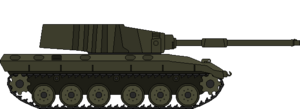| MBT-80 | |
|---|---|
 Drawing of the MBT-80 ATR2 | |
| Type | Main battle tank |
| Place of origin |
|
| Production history | |
| Designed | 1979 |
| No. built | 2 prototypes (ATR1 & ATR2) |
| Specifications | |
| Crew | 4 (commander, gunner, loader, driver) |
|
| |
| Armour | Chobham |
Main armament | 120 mm rifled gun |
| Engine |
Rolls-Royce CV12 diesel 1,500 hp |
The FV4601 MBT-80 was a British experimental third-generation main battle tank, designed in the late 1970s to replace the Chieftain tank. It was eventually cancelled in favour of the Challenger 1, itself an evolution of the Chieftain design.[1]
History[]
By the early 1970s, there was great disparity in the number of tanks being fielded by NATO and the Warsaw Pact in Europe.[1] Plans to develop a joint main battle tank for both West Germany and the United States; the MBT-70, failed after conflicting requirements for the tank and cost overruns. Looking to replace the M48 Patton and Leopard 1, West Germany cooperated with the United Kingdom to develop a Future Main Battle Tank (FMBT). This was expected to replace the UK's Chieftain tanks starting in the 1980s, as well as the older West German tanks. In 1977, Frederick Mulley, then Secretary of State for Defence, announced that, while both countries had agreed on the specifications of the joint tank, the replacement timetables diverged to such a degree that collaboration was not practicable at that time. Still looking for a Chieftain replacement, the UK began development of the MBT-80 in 1978.
Design[]
The MBT-80 was designed to counter all armoured threats from the Eastern Bloc, combining a rifled gun, advanced composite armour and increased mobility onto one platform.
Armament[]
The primary armament MBT-80 was to be a 120 mm rifled gun, similar to that found on the Chieftain and later the Challenger 1 and Challenger 2 main battle tanks.
Protection[]
The MBT-80 was going to be protected by the recently developed Chobham armour, first fielded on the American M1 Abrams. The armour would have provided greater resistance against high explosive anti-tank (HEAT) rounds and kinetic energy penetrators.
Mobility[]
The MBT-80 was to have a longer range, more mobility and greater speed then previous tanks. Two options were considered; the Honeywell AGT1500 gas turbine engine used by the United States's prototype XM1 Abrams tank, producing 1,500 hp, and a modified, turbocharged version of the Rolls-Royce CV12 diesel engine, also producing 1,500 hp. The CV12 was eventually picked, primarily due to the fact that the AGT1500 would require substantial modification of the tank to suit the associated transmission that came with the engine, which had been specially designed for the XM1. The higher fuel consumption of the gas turbine engine was also a factor in choosing the diesel engine. The CV12 was expected to be produced at Rolls-Royce's Shrewsbury plant.
Cancellation[]
In the aftermath of the Iranian Revolution, all orders for weapons from the United Kingdom were cancelled, including those for Shir 2 tanks. The British defence industry was heavily reliant on the Iranian market, forcing the government to cut the number of workers at ROF Leeds. At this same time, the government was looking into how they could still retain the skill and capacity at Leeds that would be needed to produce the next generation of main battle tanks. Despite attempts to put the tank into production as quickly as possible, it would not be until the mid-1980s that the MBT-80 would be ready for production. Ultimately, the entire programme was cancelled in favour of the Challenger 1, which had been developed from the Shir 2 and was available for service by 1983 to replace the Chieftain tanks instead.
Surviving vehicles[]
Two test rigs were built to test the various systems that would be used in the planned MBT-80. The first, ATR1, had a hull assembled from Shir-2 prototypes, removable blocks of armour that either contained Chobham or steel designed to imitate it, and a dummy tank gun. It could also move under its own propulsion. ATR1 fell into the hands of a private collector but is currently in bad condition. The second rig, ATR2, was designed to test the ability to weld aluminium and steel tank hulls together to reduce weight. It also had a different turret design to the ATR1 and possesses advanced sights that were state-of-the-art at the time of construction. ATR2 is currently displayed in the Vehicle Conservation Centre of the Bovington Tank Museum in Dorset.[2]
See also[]
References[]
- ↑ 1.0 1.1 "MBT-80" (in English). Global Security. http://www.globalsecurity.org/military/world/europe/mbt-80.htm.
- ↑ "The British MBT80 Project" (in English). TankNutDave.com. http://tanknutdave.com/the-british-mbt80-project/.
External links[]
| ||||||||||||||||||||
| ||||||||||||||||||||
The original article can be found at MBT-80 and the edit history here.